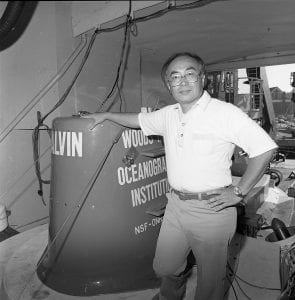Susumu Honjo
 The Woods Hole Oceanographic Institution announces with great sorrow the death of Scientist Emeritus Susumu Honjo on December 23 surrounded by his family. He was 87.
The Woods Hole Oceanographic Institution announces with great sorrow the death of Scientist Emeritus Susumu Honjo on December 23 surrounded by his family. He was 87.
Sus’s pioneering work as a scientist at WHOI contributed to the understanding and observations of marine particle compositions and fluxes and of the oceanic biological pump.
Sus was born in Japan and received his formal education at Hokkaido University in Sapporo. He was one of the first post WWII Japanese Fulbright scholars to the US at Kansas University. He was later a Post-Doctoral Fellow at Princeton University. From 1963 to 1970, he was Assistant and Associate Professor at Hokkaido University.
In 1970, Sus set down roots on Cape Cod by joining WHOI as an Associate Scientist. In 1982 he was promoted to Senior Scientist. In 2004, he became a Scientist Emeritus.
Sus held the Institution’s Columbus O’Donnell Iselin Chair for Excellence in Oceanography from 1989 to 1994. In 1998, the Japan Marine Science and Technology Center (JAMSTEC) invited Honjo to be a part-time executive director of the organization. Through JAMSTEC, he directed the establishment of a new ocean research institution, the Mutsu Institute for Oceanography, in Mutsu City, Japan. He served as the first Director of the Joint North Pacific Research Center at WHOI, a collaborative effort between Mutsu Institute of Oceanography of JAMSTEC and WHOI. In 2003, Sus received the Imperial Order of the Rising Sun for his research on the transfer of CO2 from the atmosphere to the ocean’s interior and for his efforts to strengthen Japan’s role in the international ocean science research community. He was the first oceanographer to be presented with the honor. In 2014, he was elected a fellow of the American Geophysical Union (AGU). Sus was also the very first recipient of the WHOI Distinguished Emeritus Award, which recognizes outstanding continued contributions by a Scientist or Oceanographer Emeritus to the Institution and the ocean science community. It was presented to him in 2019 in appreciation of his many accomplishments in the fields of marine geology and ocean technology.
Since the 1970s, Sus conducted experiments around the world to better understand the process, rates, and the volume of the transfer of carbon dioxide (CO2) from the atmosphere to the ocean’s interior and seafloor. As one of the first oceanographers to measure oceanic particle fluxes and examine mechanisms of particle transport, his work gave rise to the explosive research field of biogeochemical particle flux dynamics, linking biological particle production, chemical transformations, and sediment composition—with the ultimate goals of quantifying the delivery and sequestration of carbon in the deep-sea. He was a founder of the International Joint Global Ocean Flux Study (JGOFS), an international collaborative research project established in 1983 to understand the ocean carbon cycle. Through his 15-years of leadership, the project collected data through sediment traps at sites in all the major ocean basins of the world. In the 1980s, the desire to obtain particle flux samples beneath the central Arctic ice pack led Sus to develop the Arctic Environmental Drifting Buoy (AEDB) and subsequent Ice-Ocean Environmental Buoys (IOEB) in the 1990s.
His contributions to oceanography included not only his pioneering research in biogeochemical particle flux studies, but he also led the development of a number of notable oceanographic instruments over four decades including the sediment trap, moored profiler, and ice-tethered Arctic environmental buoys. In 1983, he started McLane Research Laboratories Inc., in Falmouth, Massachusetts to make his instruments commercially available to the global scientific community. The company continues to thrive, and in 2017, was awarded Massachusetts SBA Exporter of the Year. Hundreds of these instruments have been deployed in every ocean of the world, and remain a significant tool for biological pump studies today.
Sus was active in education and training programs, supervising many graduate students in the MIT/WHOI Joint Program in Oceanography and Applied Ocean Science and Engineering and postdoctoral investigators. His greatest joy to his final days was reading the research of his former students and mentees and seeing their success.
Sus is survived by his daughter, Yuki Honjo and her husband Jason Cullinane and his two cherished grandchildren. His beloved wife Kazuko “Kay” Honjo, passed in December 2019. The family plans a celebration of life for both Sus and Kazuko when the pandemic eases.
Information for this obituary is from the Honjo Family
